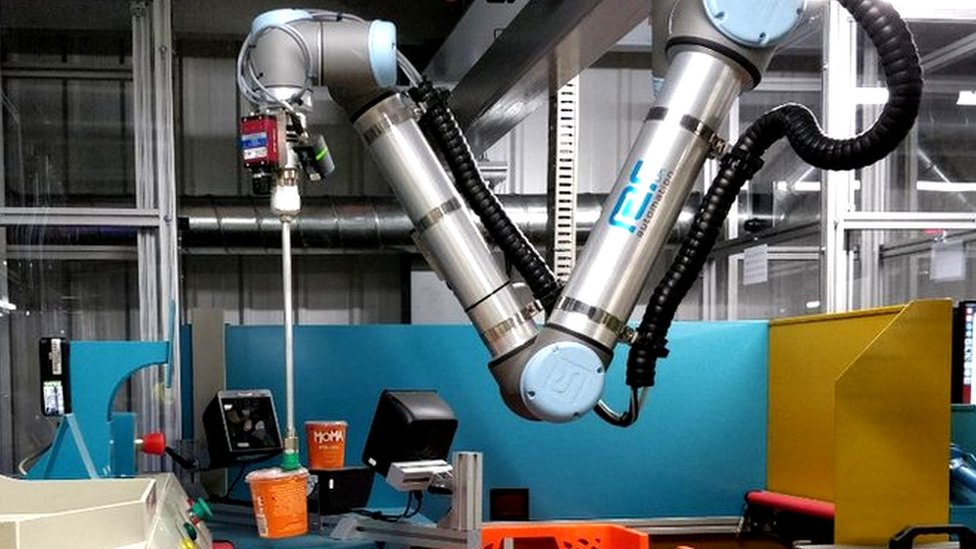INSUBCONTINENT EXCLUSIVE:
Image copyrightTheIndianSubcontinent / Zoe KleinmanThe first things you notice are the chill in the air, the vast grid on the floor which
makes you feel like you're on the film set of the movie Tron, and the whooshing sound of wheels skimming across aluminium.The last thing on
your mind is buying groceries
But that's what's going on here
I'm standing upstairs in an Ocado warehouse in Hampshire, England, where grocery orders are assembled and dispatched, watching hundreds of
cuboid robots whizz around on a vast metal grid that stretches out as far as I can see.The grocery giant doesn't often let journalists in to
its 18 acre (784,080 sq ft) Andover site.With the exception of two or three maintenance engineers on standby, my guide and I are the only
For a warehouse, it's quiet and uncluttered - and somewhat mesmerising.It processes 65,000 customer orders per week and doubles up as a sort
of living robotics lab.Image copyrightTheIndianSubcontinent / Zoe KleinmanThe robots, complete with green flashing lights, are collecting
crates of food that sit in stacks beneath the grid and delivering them to chutes, where human workers beneath take the number of items they
need to complete an order and then the crates are lifted back by the machines and returned to their spot.Next to the humans, a robotic pick
machine refines its skills, practising picking up items and putting them into boxes
It is quite possibly their future
Back on the grid, each box is home to a different sort of grocery, and the crates sit in piles
If a robot needs a crate that is not at the top, others come along and lift out the ones that stand in the way
Ocado chief technology officer Paul Clarke describes the 1,100 collaborative members of his robot swarm as "friends" - although they are, in
effect, all the same machine.Image copyrightTheIndianSubcontinent / Zoe KleinmanThey travel quickly - up to 4m per second (8.9 mph) - and
can pass within 5mm (0.2in) of each other
They don't often crash, I am told - although there are some crumpled crash barriers in sight - and recovery vehicles also wait to rescue any
breakdowns because humans cannot enter the fenced-off grid.Sometimes, eerily, they all pause at once
Occasionally they return for a battery top-up - they are never fully charged but operate on bursts, so they are never idle for long.The
machines communicate via a bespoke unlicensed 4G network created by Ocado
Image copyrightTheIndianSubcontinent / Zoe KleinmanMy guide Alexandru Voica describes them as a cross between a phone and car because of
their autonomous movement and 4G capability
They remind me a little of K9, Dr Who's vintage robot dog
The tech has already been licensed to Morrisons supermarket in the UK, Groupe Casino in France and the Sobeys chain in Canada.One expert
said the technology promised huge efficiency savings - but still had major challenges to overcome."At some stage, there are always problems
with any mechatronic system - systems will break down," explains Prof Chris Melhuish from Bristol University's Robotics Laboratory."The
trick is for them to degrade gracefully in a controllable fashion."Robots will need self-diagnostics, they need to know when they're not
performing as they ought to."No machine is infallible, and whatever intelligence it has, it has got to be sophisticated enough to know what
it is doing, what it is supposed to be doing and the difference between the two."Large scaleOcado has further ambitions to automate the
entire delivery process - but do its customers care"Some do, but many probably understandably take it for granted," said Mr Clarke."People
are increasingly becoming aware that robots and AI are behind many of the services they are starting to use
"I think they would be surprised to see the scale of the automation that we bring to bear in order to do something that looks relatively
mundane like having your groceries delivered."AI in the warehouse Image copyrightRethink roboticsImage caption
The
Sawyer robot is touch-sensitive and works alongside humans
At Alibaba's packing centre in the Guandong province of China,
robots are said to do 70% of the work
The firm says the robots have made the warehouse three times more efficient
"It helps as it saves me walking to every shelf and picking up the goods," Li Yan told TheIndianSubcontinent Click."Now I just stand at the
pick-up platform and wait for the robot to bring the goods to me."Visiting one of Amazon's most recently opened "fulfilment centres" or
delivery warehouses, the Chicago Tribune noted that the online retailer deploys at least 100,000 robots worldwide to move shelf towers
containing stock around in these centres
In 2017, delivery firm DHL Supply Chain announced that it had purchased four robots known as Sawyers to help UK warehouse staff pack goods
The firm packs more than 50 million cases each year from 19 warehouses around Britain
Sawyer robots, developed by the firm Rethink Robotics, can respond to touch and operate alongside humans.

